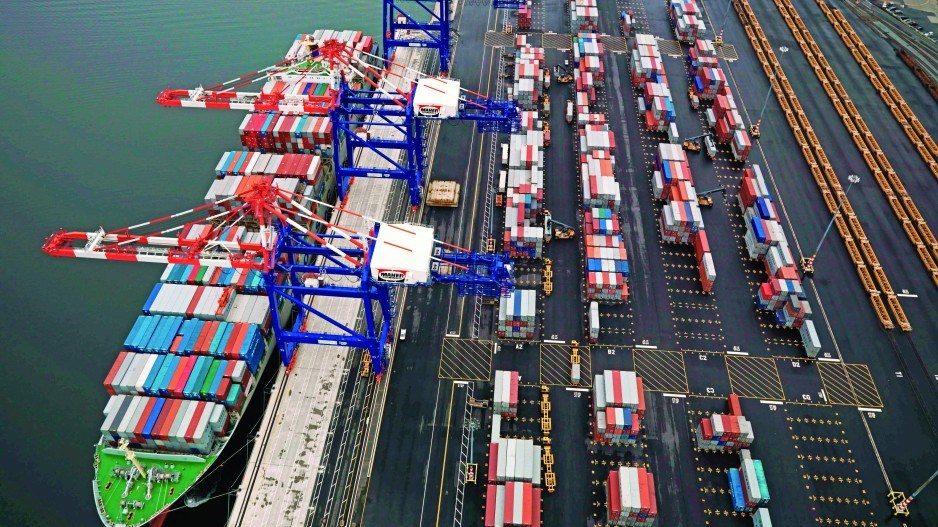Teething problems at the Port of Prince Rupert’s newly expanded Fairview Container Terminal have resulted in two major shipping lines diverting cargo to the Port of Vancouver.
COSCO Shipping Holdings Co. Ltd. (HK:1919), the first global shipping line to call at the Fairview terminal when it opened in September 2007, began rerouting containers to Vancouver last month because Fairview’s container dwell time had ballooned to seven days. A reckoning of terminal cargo-handling efficiency, dwell time measures the average time a container sits on a dock after being unloaded from a ship and before it’s loaded onto railcars or trucks. Fairview’s average dwell time for containers has been two days.
A.P. Moller-Maersk’s (CPH:-MAERSK-B) Maersk Line is also diverting its Fairview containers to Vancouver.
Its September 19 customer advisory noted that the switch to Vancouver would be in place for up to four weeks.
The world’s largest container shipping line added a second transpacific service to Vancouver and Prince Rupert in December 2016 to meet growing customer demand and add to what Maersk Canada president Jack Mahoney told Business in Vancouver were the B.C. ports’ cost-competitive options for reaching major Canadian and American markets.
He said the decision to divert cargo from Prince Rupert because of Fairview’s congestion should have minimal impact on Maersk’s customers because the shipping line leverages its “inland network to ensure cargo is delivered as planned.”
Integrating new container cranes and increasing rail-yard service as part of Fairview’s $200 million expansion have contributed to the cargo bottleneck.
Kris Schumacher, communications co-ordinator for the Port of Prince Rupert, added that a suspected on-dock dangerous-goods leak on the Sunday before Labour Day temporarily suspended terminal operations.
The timing of the shutdown, he said, was especially bad because Labour Day is one of the only days that the terminal is closed.
In addition, August container traffic through Prince Rupert, one of North America’s fastest-growing container ports, was one of the highest on record. Fairview handled close to 88,000 20-foot equivalent units (TEUs), up 37% from 64,000 in August 2016.
Schumacher said the combination of infrastructure fine tuning, a dangerous-goods shutdown and the spike in container traffic drove the decision to divert cargo to Vancouver.
He pointed out that the shipping lines, the Port of Prince Rupert and terminal operator DP World collaborated on the cargo diversion plan. Dubai-based DP World also operates the Port of Vancouver’s Centerm container terminal.
DP World’s September 15 note to Fairview customers said the company had implemented a plan to “normalize dwell times within a week and to bridge the gap to the release of the terminal’s full 1.35 [million] TEU capacity by the end of October.”
The plan, it said, aimed to reduce Fairview dwell times to around four days by week’s end.
“This certainly isn’t the norm for Prince Rupert and Fairview terminal,” Schumacher said. “We pride ourselves on productivity and fluidity at the terminal.”
He added that one of the key contributors to Fairview’s success has been its collaborative partnership of customers and stakeholders.
“If anything this can be seen as evidence of how strong those relationships are and how agreeable the working relationship that the various partners have to be able to put together a plan to make sure things get back to normal as soon as possible.”
Mahoney said in an email that his most recent communications with DP World and Canadian National Railway Co. (TSX:CNR) indicated that progress was being made in Prince Rupert’s recovery from the cargo backlog, which gives “added confidence this is only a temporary move,” one Maersk made for its customers “and in co-operation with the terminal operator and railroad.”
Schumacher said Fairview’s operations should be back to normal by the end of October.
Other major shipping lines that now call at Prince Rupert include Yang Ming Marine (TPE:2609), Evergreen Marine Corp. (TPE:2603) and the CMA CGM Group.
At the end of August, the port and DP World celebrated the completion of the two-year, $200 million project to expand Fairview’s annual container-handling capacity to 1.35 million TEUs from 776,412 and allow the terminal to handle the largest container cargo vessels being deployed in global freighter fleets.
DP World, which has 78 container terminals in 40 countries around the world, handled approximately 64 million TEUs in 2016. In 2017’s first six months, it posted revenue of US$2.3 billion, a 9.6% increase over 2016’s first six months.
Its investment in Fairview’s expansion comes from the $5 billion funding pool it created last December in its partnership with Caisse de dépôt et placement du Québec, Canada’s second-largest pension fund manager. DP World originally acquired Fairview from Deutsche Bank (NYSE:DB) in April 2015 for $580 million.
It also plans to invest $350 million in expanding its Centerm container terminal on Burrard Inlet to expand its annual capacity to 1.5 million TEUs from the current 900,000.•
@timothyrenshaw




